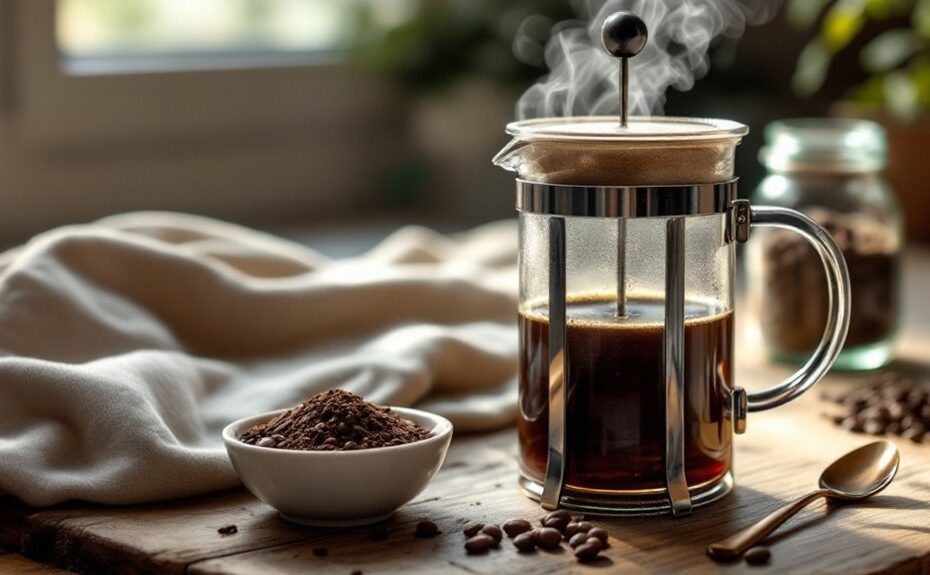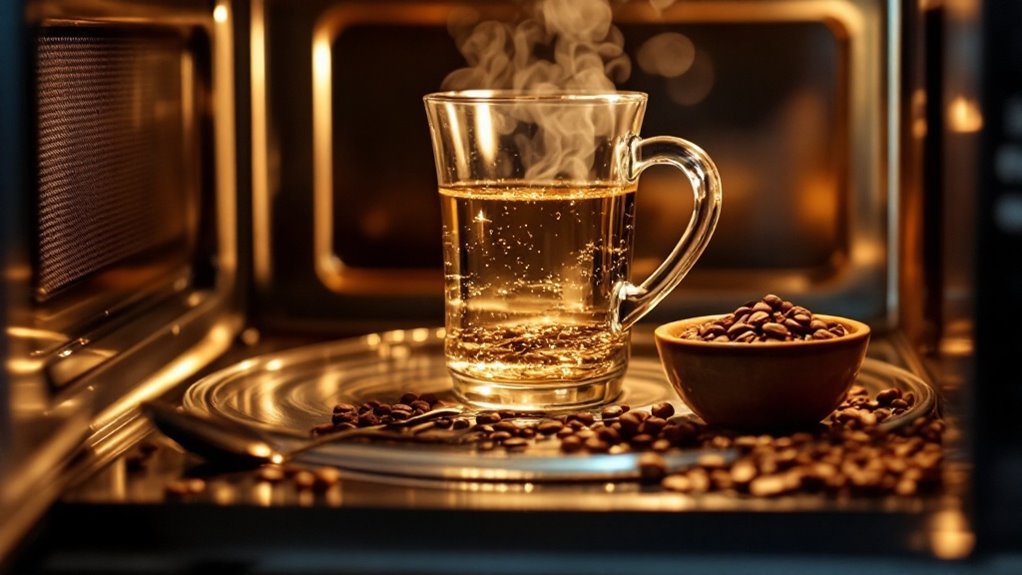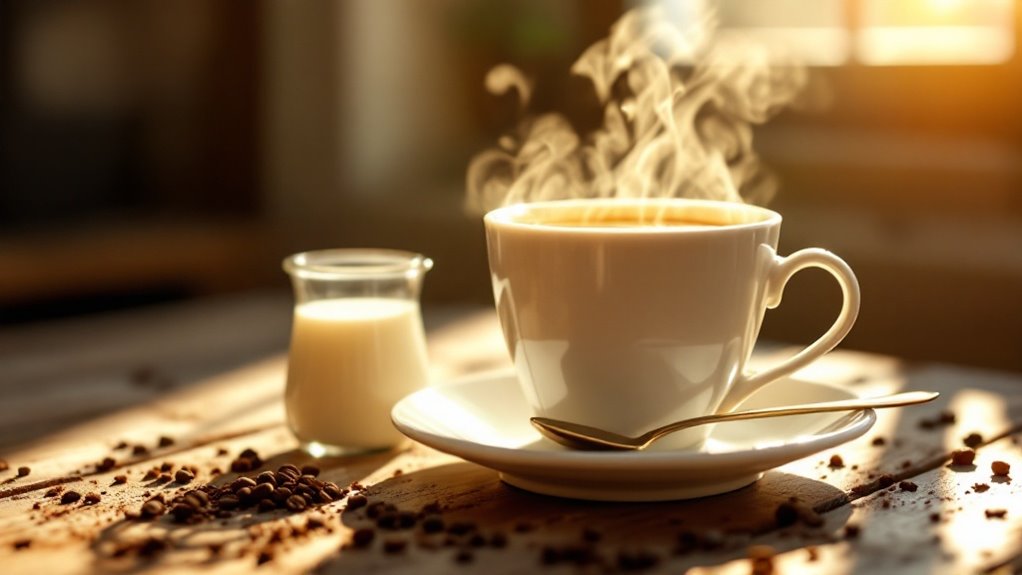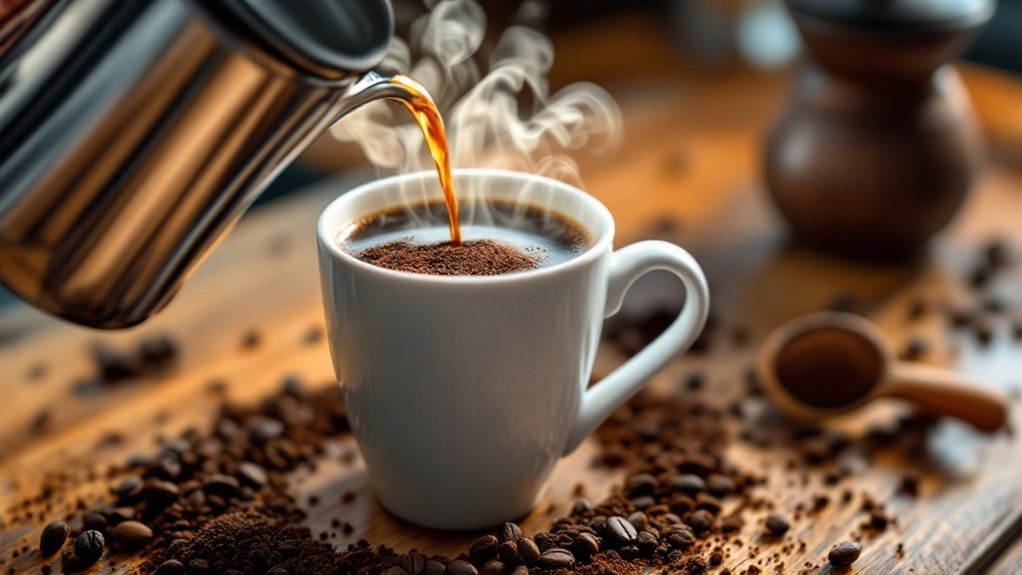







You might not realize that decaf coffee can lose up to 30% of its flavor during the decaffeination process, but the method you choose can make all the difference. The Swiss Water Process and CO2 method are known for preserving more of the bean's natural taste, yet how you grind and brew those beans matters just as much. From water temperature to brewing ratios, small adjustments can transform your cup. But what's the secret to balancing flavor and avoiding bitterness? The answer lies in understanding the nuances of decaf, and there's more to uncover about crafting the perfect brew.
Key Takeaways
- Choose high-quality decaf beans processed via Swiss Water or CO2 methods for optimal flavor preservation.
- Grind decaf beans to a medium consistency using a burr grinder for even extraction and balanced flavor.
- Brew with water at 195-205°F to avoid over-extraction and preserve delicate flavor compounds.
- Use a coffee-to-water ratio of 1:15 to 1:17 for a well-balanced and flavorful cup of decaf coffee.
- Avoid common mistakes like using stale beans, boiling water, or skipping the bloom phase for best results.
Understanding Decaffeination Methods
Decaffeination transforms regular coffee beans into a caffeine-free or low-caffeine alternative, but the method used can substantially impact flavor and quality. The Swiss Water method is a solvent-free process that relies on water and activated carbon to extract caffeine from green coffee beans while preserving their natural flavor compounds. This method is prized for its ability to maintain a clean, balanced flavor profile without introducing chemicals. In contrast, solvent-based methods like methylene chloride or ethyl acetate involve soaking green coffee beans in chemical solutions to dissolve caffeine. While effective, these methods can strip away some flavor molecules, potentially altering the bean's inherent taste. Another advanced technique, supercritical CO2 decaffeination, uses pressurized carbon dioxide to selectively bind and remove caffeine, leaving most flavor molecules intact. Regardless of the method, decaffeination typically occurs at the green coffee stage to minimize flavor loss during roasting. Most decaf coffee retains trace amounts of caffeine, with methods removing 97-99.9% of the original content. Understanding these processes helps you appreciate how decaffeination influences the final cup, from flavor nuances to overall quality.
Choosing High-Quality Decaf Beans
Selecting high-quality decaf beans starts with understanding how the decaffeination process affects flavor and sourcing. Look for beans processed using the Swiss Water Process or CO2 method, as these methods preserve flavor without chemical solvents, guaranteeing a cleaner cup. Specialty coffee-grade decaf beans are ideal, as they're sourced from high-quality arabica coffee and roasted with precision to highlight nuanced flavor profiles. Check for certifications like organic or Fair Trade to verify ethical and sustainable sourcing practices. When choosing decaf, read labels or descriptions to confirm the decaffeination method, as some processes retain more flavor compounds than others. Experiment with single-origin decaf beans to explore unique flavor profiles, such as fruity, floral, or chocolatey notes, which can elevate your brewing experience. Whether you're using a pour-over, French press, or espresso machine, high-quality decaf beans processed through methods like the Swiss Water Process will deliver a balanced, flavorful cup. Prioritize freshness by purchasing from reputable roasters who provide roast dates, securing your decaf beans are at their peak for brewing.
The Swiss Water Process Explained
The Swiss Water Process relies on water and carbon filtration to remove caffeine without chemical solvents, ensuring a solvent-free extraction. Green coffee beans are soaked in a caffeine-free green coffee extract, allowing caffeine to diffuse out while retaining the beans' essential flavor compounds. This method preserves the coffee's natural flavor profile, making it ideal for specialty decaf with minimal impact on taste.
Water and Carbon Filtration
Water and activated carbon filters are the backbone of the Swiss Water Process, a chemical-free method that strips caffeine while preserving the coffee's natural flavor compounds. In this decaffeination process, green coffee beans are soaked in hot water, which dissolves caffeine molecules and other soluble compounds. The water, now rich with these elements, passes through activated charcoal filters. These filters are designed to trap caffeine molecules while allowing the flavor-rich compounds to remain in the solution. This creates a caffeine-free green coffee extract, which is then reused to soak new batches of beans. The extract guarantees that only caffeine is removed, leaving the beans' original flavor profile intact. By relying on osmosis and the selective filtration properties of activated charcoal, the Swiss Water Process achieves 99.9% caffeine removal without chemical solvents. This method not only maintains the coffee's complexity but also aligns with organic and kosher standards, making it a preferred choice for specialty coffee enthusiasts. The result is a decaf coffee that retains the nuanced flavors of its caffeinated counterpart.
Solvent-Free Caffeine Removal
Building on the role of water and carbon filtration in decaffeination, the Swiss Water Process stands out as a solvent-free method for caffeine removal. This method relies on water, temperature, and time to extract caffeine from green beans without using chemical solvents. The process begins by soaking the beans in a caffeine-free green coffee extract, which allows caffeine to diffuse out naturally through osmosis. The caffeine-laden water is then filtered through activated charcoal, capturing caffeine molecules while preserving the coffee's aroma and flavour compounds. This guarantees that 99.9% of the caffeine is removed, leaving the beans decaffeinated but rich in their original characteristics. Coffee roasters often favor this method because it maintains the integrity of the green beans, resulting in a final product that closely mirrors the taste of its caffeinated counterpart. Certified organic and kosher, the Swiss Water Process is a sustainable choice for specialty decaf coffee, appealing to those who prioritize both quality and ethical production practices. By avoiding solvents, it delivers a clean, flavorful cup that satisfies even the most discerning coffee enthusiasts.
Flavor Preservation Techniques
Flavor preservation in the Swiss Water Process hinges on its ability to isolate and retain the coffee's essential oils and flavor compounds while removing caffeine. This method relies on osmosis and a green coffee extract to decaffeinate green coffee beans without chemical solvents. By soaking the beans in water, caffeine diffuses out, but the flavor compounds remain intact. The process uses a proprietary solution called Green Coffee Extract (GCE), which is saturated with the beans' natural flavor molecules, ensuring they aren't lost during decaffeination.
The caffeine-laden water is filtered through activated charcoal, which captures caffeine molecules while allowing the flavor compounds to stay in the solution. This cycle repeats for up to 10 hours, ensuring 99.9% caffeine removal while preserving the coffee's aromatic and flavor integrity. The result is decaf coffee that retains the original flavor profile of the green coffee beans, making it ideal for specialty brewing methods like pour-over or French press. Certified organic and kosher, the Swiss Water Process is a benchmark for flavor preservation in decaf coffee, offering a clean, chemical-free cup that doesn't compromise on taste.
Grinding Decaf Coffee Beans Properly
To achieve the best results when grinding decaf coffee beans, start by selecting a burr grinder for consistent particle size, aiming for a medium grind that resembles granulated sugar. This grind size works well for most brewing methods, such as drip coffee or pour-over, ensuring balanced extraction and ideal flavor profiles. Adjust the grind size based on your brewing method: go finer for espresso (20-30 seconds extraction) and coarser for French press (4 minutes steeping). Decaf beans are often more brittle due to the decaffeination process, so monitor grind consistency to avoid over-extraction, which can lead to bitterness. Always grind your decaf coffee beans just before brewing to preserve freshness and prevent oxidation, which can dull the delicate flavors. Store whole decaf beans in an airtight container away from light and heat to maintain their quality before grinding. By paying attention to grind size and consistency, you'll enhance the flavor of your decaf coffee, ensuring a smooth and enjoyable cup tailored to your preferred brewing method.
Optimal Brewing Techniques for Decaf
After grinding your decaf coffee beans to the appropriate size, focus on brewing techniques to maximize flavor and balance. Decaffeinated coffee requires careful handling, as the beans are soaked during processing, which can make them more porous and prone to over-extraction. Use a medium grind size to guarantee even extraction and avoid bitterness. Brew with hot water at 195-200°F to preserve the delicate coffee flavours that might be compromised by the decaffeination process.
For the best results, choose a brewing method like pour-over or French press, which allows precise control over extraction time and water flow. These methods highlight the nuanced profiles of decaf coffee, making them ideal for coffee drinkers seeking a balanced cup. Slightly increase the coffee-to-water ratio, such as 1:15, to compensate for any flavor loss during decaffeination. Avoid over-roasting decaf beans, as they darken faster and can develop a burnt taste, masking the subtle notes. By adjusting your brewing approach, you'll reveal the full potential of decaf coffee, delivering a rich and satisfying experience.
Water Temperature and Brewing Ratios
Heat your water to 195-205°F (90-96°C) to guarantee proper extraction without scorching the decaf beans, which can lead to bitter or flat flavors. Aim for a brewing ratio of 1:15 to 1:17 (coffee to water) to achieve a balanced cup with the right strength and clarity. Avoid boiling water, as it can over-extract the delicate compounds in decaf, resulting in an unpleasant taste profile.
Optimal Water Temperature
Why does water temperature matter when brewing decaf coffee? Water temperature directly impacts extraction, which determines the balance of flavors in your cup. For decaf coffee, aim for a range of 195°F to 205°F (90°C to 96°C). This range guarantees ideal extraction of soluble compounds without degrading the delicate flavors of decaf beans. If the water temperature is too low—below 195°F—you risk under-extraction, resulting in a weak, flat brew lacking complexity. Conversely, temperatures above 205°F can over-extract the coffee, pulling out bitter and astringent compounds that mask the nuanced flavors of decaf.
Decaf coffee, despite its reduced caffeine content, still contains aromatic oils and soluble solids that require precise brewing conditions. Maintaining the correct water temperature guarantees these compounds are extracted evenly, enhancing the coffee's body, acidity, and sweetness. Preheating your brewing equipment, such as a French press or pour-over cone, helps stabilize the water temperature during brewing. This consistency prevents temperature fluctuations that could disrupt extraction. By controlling water temperature, you'll achieve a well-balanced decaf coffee with a clean, flavorful profile, free from the pitfalls of under- or over-extraction.
Ideal Brewing Ratios
Achieving the perfect cup of decaf coffee hinges on mastering the ideal brewing ratio, which balances coffee grounds and water to extract the best flavor. Start with a coffee to water ratio of 1:15 to 1:18, using 15-18 grams of decaf beans for every 8 ounces of water. This range guarantees a balanced flavor profile without over-extraction, which can lead to bitterness. If you're using a French press, adjust the ratio slightly to 1:16 to account for the immersion brewing method, which requires a coarser grind and longer steeping time. Consistency in brewing ratios is key to replicating your preferred flavor profiles, especially with decaf coffee, which can have subtle differences in extraction compared to regular beans. Pair your ratio with water heated to 195°F–205°F (90°C–96°C) for ideal extraction of the decaf beans' nuanced flavors. Experiment within these parameters to fine-tune your brew, making certain each cup delivers the richness and complexity you expect from decaf coffee.
Comparing Decaf and Regular Coffee Flavor
How does decaf coffee stack up against its caffeinated counterpart in terms of flavor? Decaf coffees often exhibit a milder taste of coffee due to the removal of caffeine, which contributes to bitterness and complexity. The caffeine content in decaf is reduced by 97-99.9%, which can result in a less robust flavor profile compared to regular coffee. However, the decaffeination method plays a significant role in preserving or altering the taste. Solvent-based methods, such as ethyl acetate processing, can introduce subtle chemical notes, potentially affecting the overall flavor. In contrast, the Swiss Water Process and CO2 methods are gentler, retaining more of the coffee's natural compounds and delivering a flavor closer to regular coffee. When brewing decaf, you may notice a slightly lighter body and reduced acidity, but high-quality beans processed using advanced techniques can still offer a rich, aromatic experience. To maximize flavor, adjust your brewing parameters, such as grind size and water temperature, to suit the unique characteristics of decaf. While decaf may not match the full intensity of regular coffee, it can still provide a satisfying and nuanced cup when crafted with care.
Health Benefits of Decaf Coffee
Decaf coffee offers several notable health benefits, making it a compelling choice for those seeking a caffeine-free alternative. When you decaffeinate coffee, it retains antioxidants like chlorogenic acid, which can reduce inflammation and lower the risk of chronic diseases. These compounds also contribute to improved liver function, potentially reducing the risk of conditions like cirrhosis and liver cancer. Studies show that drinking decaf coffee is associated with a 7% lower risk of type 2 diabetes, similar to regular coffee, due to its bioactive compounds.
Additionally, decaf coffee supports heart health by helping to lower blood pressure and reduce the risk of stroke. Its small amounts of caffeine make it a safer option for individuals sensitive to caffeine or those with sleep disorders, while still providing the comforting ritual and flavor profiles of traditional coffee. Whether you brew it using a French press, pour-over, or drip method, decaf coffee delivers these health benefits without the jitters or sleep disruptions often linked to higher caffeine intake. By incorporating decaf into your routine, you can enjoy its protective effects while savoring its nuanced flavors.
Common Mistakes to Avoid When Brewing Decaf
While decaf coffee offers numerous health benefits, brewing it requires careful attention to avoid common pitfalls that can compromise its flavor. One mistake is using water that's too hot, as decaf beans are more delicate and can over-extract, resulting in a bitter taste. Aim for a water temperature between 195°F and 205°F to preserve the beans' nuanced flavor profiles. Another error is grinding the beans too finely, which can clog filters in methods like French press or drip coffee makers. Opt for a medium grind to guarantee proper extraction without clogging. Skipping the bloom phase is also problematic; even though the process of extracting caffeine involves soaking the beans, they still release gases that need to escape during brewing. Blooming for 30 seconds helps achieve even extraction. Avoid using stale decaf beans, as they lose flavor faster than regular beans, leading to a flat brew. Finally, don't assume decaf requires less brewing time—follow the same guidelines as regular coffee to secure the best flavor extraction. By avoiding these mistakes, you'll craft a balanced and enjoyable cup of decaf.
Disclosure: As an Amazon Associate, I earn from qualifying purchases.





